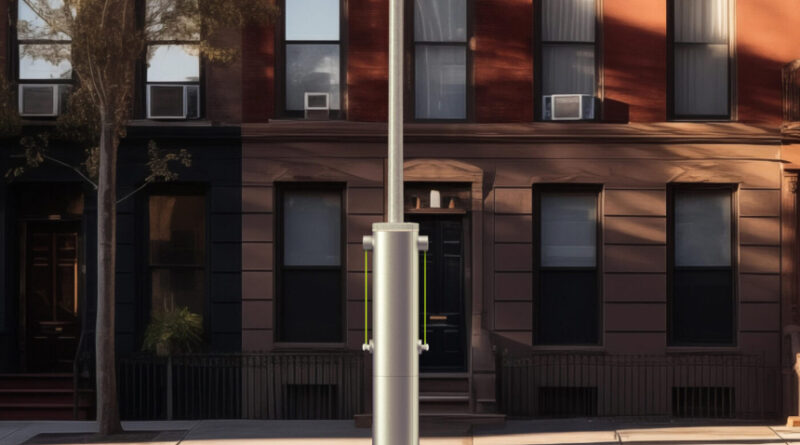Voltpost Wants To Bring EV Charging To American Cities
Most people who drive electric cars charge them at home in their driveway or garage. But what if you live in a city like New York where many residents park wherever they can find a space on the street? There are a lot of drivers like that in American cities (and around the world), and they are unlikely to buy a plug-in hybrid or battery electric car until they have access to convenient charging. Voltpost thinks it has an answer that is quick, convenient, and cost effective.
This week, it announced it is developing and deploying a system that converts ordinary light poles into EV chargers in New York, Chicago, Detroit, and other major US metropolitan areas this spring. “Voltpost is striving to make EV chargers as common as the traditional lamppost. We are empowering people with convenient and affordable charging access that fits into the fabric of the built environment,” says Jeff Prosserman, co-founder and CEO of Voltpost. “As we bring our differentiated curbside and parking lot charging solution to market, we are confident that Voltpost will build more sustainable and resilient communities by decarbonizing mobility.”
Voltpost transforms lampposts into a modular and upgradable Level 2 EV charging platform powered by a mobile app. The company claims a short installation time of one to two hours as well as low maintenance needs. The charging posts themselves have either 2 or 4 charging ports and feature a 20-foot-long charging cable “for convenient access to any part of the vehicle.” The chargers are built in the US.
Voltpost Leverages Existing Infrastructure
Autoblog says the Voltpost device is basically a shroud that covers the lower part of a lamppost. The shroud contains all the electronics and cables required to provide AC Level 2 charging for two to four EVs. It’s not fast charging, but it’s more than enough for most people to top off overnight. The company has not provided specifications about how much charging power each unit supplies, but it seems safe to assume that if two cars are plugged into one Voltpost unit, the charging power will be half what it would be if only one car is charging.
Readers might also want to know more about NACS vs CCS charging comparability at a time when all of North America is adopting the Tesla NACS charging standard. They may also be curious how well the the system protects against vandalism to the charging cable — a growing concern, as thieves are known to cut them to steal the copper in the wires.

The Voltpost charging platform is particularly valuable for urban EV drivers living in multi-unit housing buildings that lack dedicated parking spaces and have nowhere to charge an EV near where their residents live. The ease of installation will help bring more EV charging to underserved communities, high-density areas, and other “charging deserts,” the company says.
Modular Design & Convenient Operation
The modular platform design of the Voltpost permits for quick and easy exchanges and upgrades while maximizing system uptime and reducing operating and maintenance costs. A Charge Station Management System includes a mobile app that lets drivers manage charging events and access a map of available and in-use Voltpost chargers. The app lets users make reservations, track charging events, and pay for each charging session. The Charge Station Management System also supplies charging analytics for public and private stakeholders and lets them set charger features, including pricing, and remotely monitor chargers.
“Many people hesitate to buy an EV due to range anxiety and lack of charging options—imagine what that’s like for people living in cities in multi-unit dwellings and no dedicated parking,” said Voltpost advisor Laura Fox, who is the co-founder and managing partner at Streetlife Ventures. She is also the former general manager of Citi Bike. “Voltpost’s solution is a no-brainer for urban curbside charging. It uses and upgrades existing urban infrastructure (lampposts) for a fraction of the cost of traditional approaches, while enabling future urban use cases for that infrastructure — from 5G installs to air quality monitoring, e-bike charging and more. The Voltpost team has the vision and experience to provide urban EV users across all economic backgrounds with access to charging and accelerate the electric mobility transition.”
Last year, Voltpost participated in the New York City Department of Transportation Studio program, a collaboration between the department and Newlab. During the year, Voltpost piloted the installation of charging stations on lampposts at Newlab and in a DOT parking lot. Feedback from those locations provided insights into cost-effective and efficient deployment strategies to better plan and manage the commercial launch of the company’s lamppost charging systems. Those chargers were quickly installed in one hour, operated with the highest uptime of any service in the pilot program, and elicited positive feedback from New York drivers.
The Takeaway
At first blush, the Voltpost technology is brilliant. The biggest cost of installing urban charging equipment is the trenching needed to supply electrical power to those chargers, which can involve tearing up sidewalks or streets. Doing so is neither quick nor cheap. Lampposts by definition have a readily available supply of electricity inside just waiting to be tapped.
We here at CleanTechnica are not electrical engineers, nor have we ever played one on TV, but a quick visit to Quora found this information: “The operating voltage of a typical streetlight in the USA is usually around 120–277 volts. This range accommodates the different voltage levels used in various locations across the country.” In the comments, people with some knowledge of the subject posted that “most large scale installations operate on 480 VAC 3 phase feeds, so the individual luminaries are 277 VAC (one phase to neutral.) In residential areas the luminaries are commonly 120 or 240VAC single phase.”
But that doesn’t tell us what the amperage available at the charging plug on the end of the Voltpost charging cable is, which makes it hard to know how long it will take to charge a particular electric car using this system. We also don’t know if drivers are expected to move their cars once they are fully charged. In most instances, a city dweller who parks at the curb in the afternoon would be reluctant to get up in the middle of the night to move the car to a different location. Finally, there is the issue of what to do with scofflaws who park their conventional cars in front of a Voltpost charger. In a recent article, an author I hold in the highest esteem reported on a similar curbside charging system operated by FLO that found the incidence of ICEd chargers was not as frequent as feared but still persistent.
There’s theory and then there’s reality. Curbside charging seems like the solution city dwellers need in order to feel assured that if they buy an electric car, they will be able to charge it conveniently. Few ideas are perfect the very first time they are tried. Feedback and experience will help refine these systems so they can fulfill their promise reliably. The lessons learned by Voltpost will prove invaluable to all EV drivers as the EV revolution moves forward.
Have a tip for CleanTechnica? Want to advertise? Want to suggest a guest for our CleanTech Talk podcast? Contact us here.
Latest CleanTechnica.TV Video

CleanTechnica uses affiliate links. See our policy here.

